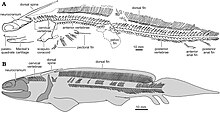| Orthacanthus | |
|---|---|

| |
| Fossil interpretation of juvenile specimen of O. platypternus (top) and skeletal reconstruction of juvenile specimen of O. bohemicus (bottom) | |

| |
| Front view of skull, American Museum of Natural History | |
| Scientific classification | |
| Domain: | Eukaryota |
| Kingdom: | Animalia |
| Phylum: | Chordata |
| Class: | Chondrichthyes |
| Subclass: | Elasmobranchii |
| Order: | †Xenacanthida |
| Family: | †Orthacanthidae Heyler and Poplin, 1989 |
| Genus: | †Orthacanthus Agassiz, 1843 |
| Species | |
| |
Orthacanthus is an extinct genus of fresh-water xenacanthiform cartilaginous fish, named by Louis Agassiz in 1843,[3][4] ranging from the Upper Carboniferous[3] into the Lower Permian.[1] Orthacanthus had a nektobenthic life habitat, with a carnivorous diet.[5] Multiple authors have also discovered evidence of cannibalism in the diet of Orthacanthus and of "filial cannibalism" where adult Orthacanthus preyed upon juvenile Orthacanthus.[6] Synonyms of the genus Orthacanthus are Dittodus Owen, 1867, Didymodus Cope, 1883, Diplodus Agassiz, 1843,[5] Chilodus Giebel, 1848 (preoccupied by Chilodus Müller & Troschel, 1844).[3]
During the Late Carboniferous-Early Permian, Orthacanthus was an apex predator of freshwater swamps and bayous in Europe and North America.[6] Mature Orthacanthus reached nearly 3 meters (10 feet) in length.[6] Orthacanthus teeth have a minimum of three cusps, two principal cusps, and an intermediate cusp, where the principal cusps are variously serrated, with complex base morphology.[7][4] Additionally, Orthacanthus can be diagnosed by major transverse axes of proximal ends at a 45-degree angle to and often almost parallel to the labial margin of the base between the cusps.[4] Deformed teeth are characteristic of the xenacanthiform sharks and of Orthacanthus.[8]
- ^ a b Hampe, O. "On the Dentition of Orthacanthus (Chondrichthyes, Xencanthida) Upper Carboniferous-Lower Permian." Palaont Z 62.3-4 (1988).
- ^ Baird, Donald; Hook, Robert W. (1986). "The Diamond Coal Mine of Linton, Ohio, and Its Pennsylvanian-Age Vertebrates". Journal of Vertebrate Paleontology. 6 (2): 174–190. Bibcode:1986JVPal...6..174H. doi:10.1080/02724634.1986.10011609. JSTOR 4523086.
- ^ a b c Babcock, L. E. (2024). ""Replacement names for two species of Orthacanthus Agassiz, 1843 (Chondrichthyes, Xenacanthiformes), and discussion of Giebelodus Whitley, 1940, replacement name for Chilodus Giebel, 1848 (Chondrichthyes, Xenacanthiformes), preoccupied by Chilodus Müller & Troschel, 1844 (Actinopterygii, Characiformes)."". ZooKeys (1188): 219–226. doi:10.3897/zookeys.1188.108571. PMC 10790574. PMID 38230382.
- ^ a b c Johnson, Gary D.; Thayer, David W. (2009). "Early Pennsylvanian Xenacanth Chondrichthyans from the Swisshelm Mountains, Arizona, USA". Acta Palaeontologica Polonica. 54 (4): 649–668. doi:10.4202/app.2008.0051. ISSN 0567-7920. S2CID 54093505.
- ^ a b "PBDB". paleobiodb.org. Retrieved 2020-03-04.
- ^ a b c Gogáin, Aodhán Ó; Falcon-Lang, Howard J.; Carpenter, David K.; Miller, Randall F.; Benton, Michael J.; Pufahl, Peir K.; Ruta, Marcello; Davies, Thomas G.; Hinds, Steven J.; Stimson, Matthew R. (11 August 2016). "Data from: Fish and tetrapod communities across a marine to brackish salinity gradient in the Pennsylvanian (early Moscovian) Minto Formation of New Brunswick, Canada, and their palaeoecological and palaeogeographical implications" (PDF). Palaeontology. doi:10.1111/pala.12249. ISSN 1475-4983. S2CID 132845922.
- ^ Johnson, Gary D. (2012). "Possible origin of the xenacanth sharksOrthacanthus texensisandOrthacanthus platypternusin the Lower Permian of Texas, USA". Historical Biology. 24 (4): 369–379. Bibcode:2012HBio...24..369J. doi:10.1080/08912963.2012.669128. ISSN 0891-2963. S2CID 128880622.
- ^ Johnson, G. D. (2018). "Orthacanthus platypternus (Cope, 1883) (Chondrichthyes: Xenacanthiformes) teeth and other isolated vertebrate remains from a single horizon in the early Permian (Artinskian) Craddock Bonebed, lower Clear Fork Group, Baylor County, Texas, USA". Acta Geologica Polonica. 68 (3). doi:10.1515/agp-2018-0025 (inactive 1 November 2024). ISSN 0001-5709.
{{cite journal}}: CS1 maint: DOI inactive as of November 2024 (link)